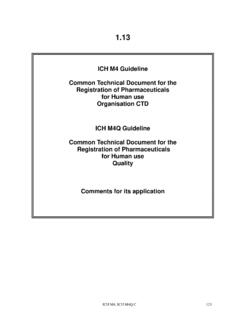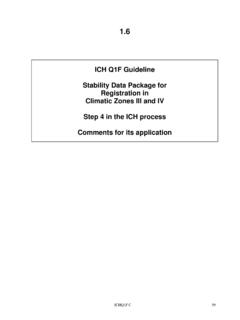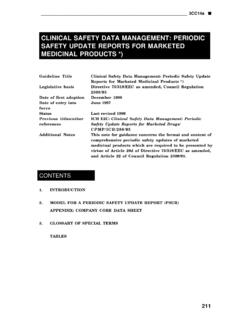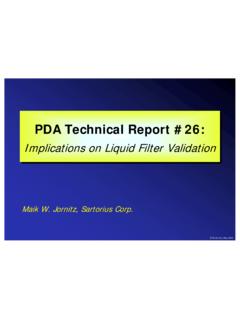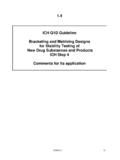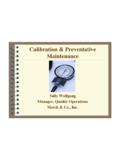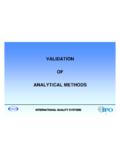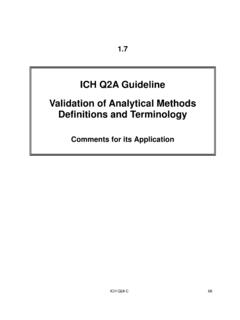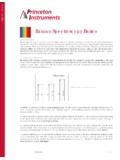Transcription of Basic Principles of Pharmacovigilance and Data …
1 IBEJ. HasfordMunichBasic Principles of Pharmacovigilance and data SourcesJoerg Hasford, , Research GroupDepartment of Medical Informatics, Biometry and Epidemiology, University of MunichEmail: HasfordMunichPharmacovigilanceThe science and activities relating to the detection, assessment, understanding and prevention of adverse effects or any other drug-related HasfordMunichPharmacovigilance9collects, records, codes ADEs / ADRs9analyses and assesses the reports9promotes the safe use of drugs9creates appropriate structures and means of communication needed to perform its tasksIBEJ. HasfordMunichAims of Pharmacovigilance9to improve patient care and safety9to improve public health and safety9to contribute to the assessment of benefit, harm, effectiveness and risk of medicines9to promote education and clinical training9to promote effective communication to the public9to promote rational and safe use of medicinesIBEJ.
2 HasfordMunichReaction / Adverse Drug ReactionAdverse Reaction means a response to a medicinal product which is noxious and unintended and which occurs at doses normally used in man for the prophylaxis, diagnosis or therapy of disease or for the restoration, correction or modification of physiological reaction, contrary to an event is characterised by the fact that a causal relationship between the drug and the occurrence is suspected, judged possible by the reporting or a reviewing health care HasfordMunichPharmacovigilance - data Sources 9 Spontaneous Reporting Systems National PV Centre / Drug Authority from the published scientific literature and Drug Bulletins9 Adverse Reaction Case Reports by the MA holder ( collected by sales representatives)9 Periodic Safety Update Report (PSUR) provided by MA holderIBEJ.
3 HasfordMunichBasic Model of PharmacovigilanceRxObservations,Diagnosi ng a potential ADRAE / ADRR eportPV-CenterzCausality AssessmentzInterpretationzAnalyseszActio nsphysicianpatientIBEJ. HasfordMunichLimitations of Spontaneous ReportingUnderreporting Nominator ?Incidence ?Number of exposed Denominator ?peopleIncidence ?Quality and missing Valid Assessment ?dataCausality ?Causality Assessment Limited reliabilityIBEJ. HasfordMunichLeading Role of Spontaneous Reporting9covers all drug use of all populations913/18 of the most important ADRs before 1982 have been signaled for the first time by SRs (Venning 1983)9 More than 50% of all alert black boxes in the PDR derive from SRs(Beach 1998)IBEJ. HasfordMunichHow to improve Spontaneous Reporting Systems?9 Regionalisation9 Combination with DIC-activities9 Retrieval of additional information9 Access to all relevant pre- and post-marketing information9 Access to detailed drug utilization data9 Standardized Assessment of causality and seriousness9 StimulationIBEJ.
4 HasfordMunichAssessment of AE / ADR-Reports9 Seriousness / Severity ICH NCI9 Frequency9 Causality9 Pattern, pre-disposing risk factorsIBEJ. HasfordMunichAdverse Reaction Report - minimum information an identifiable source a patient a suspected product a suspected reactionIBEJ. HasfordMunichSerious adverse reaction means an adverse reaction which results in death, is life-threatening, requires inpatient hospitalisation, or prolongation of existing hospitalisation, results in persistent or significant disability or incapacity, or is a congenital anomaly / birth Adverse ReactionVolume 9 - PharmacovigilanceIBEJ. HasfordMunichIBEJ. HasfordMunichCausality AssessmentPROBLEMT here is a large interobserver variability when assessing the causality of a single algorithm may help to assess reliably causality and to identify causes for disagreement.
5 IBEJ. HasfordMunichCausality AssessmentMAJOR CRITERIA Has the suspected drug actually been administered? Is the time interval between drug administration and occurrence of the ADR adequate? Is there an alternative reasonable cause for the AE? Did the AE disappear once the suspected drug was withdrawn or reduced (Dechallenge)? Did the AE reoccur once the suspected drug was re-administered (Rechallenge)? Where the drug levels measured and in favor of a type A reaction? Had the patients a disposition for this ADR?IBEJ. HasfordMunichTerms for Description of Causality unrelated possible probable definite not assessableIBEJ. HasfordMunichProfile of cutaneous reactions of tricyclic AntidepressantsIBEJ. HasfordMunichSignal - DefinitionA signal is a set of data constituting a hypothesis that is relevant to the rational and safe use of a drug in Meyboom et al.
6 1997A signal is reported information on a possible causal relationship between an adverse event and a drug, of which the relationship is unknown or incompletely documented et al. 2000 IBEJ. HasfordMunichthree convincing ADR-reports# specified ADR-Reports# Prescriptions# specified ADR-Reports (PRRs)all Reports# specified Reports / Exposed PersonsBackground IncidenceSignal GenerationXXXXIBEJ. HasfordMunichRifabutinall other drugsUveitis41754all other Reporting Ratio - ExamplePRR =586 2 and Evans et al.: Pharmacoepidemiol Drug Saf 2001:10:483-466 IBEJ. HasfordMunichProportional Reporting Ratiodrug of all other drugs interestin data basereaction(s) of interestaball other reactionscdtotala + cb + dPRR: a / a+c: b / b+dPRR = 1: no signaldefinition of signalsPRR 2 2 4minimum 3 Evans et al.
7 : Pharmacoepidemiol Drug Saf 2001:10:483-466 IBEJ. HasfordMunichProportional Reporting Ratio strict causality assessment not essential simple, transparent statistics no exposure data needed only little bias by reporting behaviour very strong signals for a particular ADR may hide a less strong signal for another ADRIBEJ. HasfordMunichPromotion of the Safe Use of DrugsCommunicationThe players MAH Drug Authority Media Physicians PatientsDecision MakingEducationEvaluationIBEJ. HasfordMunichMarket Authorization Holder9collect, collate, validate and follow up (SAEs) of all reported suspected Adverse Events9screen the relevant world-wide literature at least once / week9report all serious suspected ADRs within 15 days9submit PSURs9company-sponsored Post-Authorisation Safety Studies9regularly checks risks and benefits and acts accordinglyIBEJ.
8 HasfordMunichDrug Authority9collect, validate, code, store and analyse reports9transmit ADR data to the MA holder9inform health care professionals and, when needed, treated patients, of any significant changes9 Decision Making9 Communication with all interested parties9 Evaluation of the actions takenIBEJ. HasfordMunichMarketing Authorisation Holder Establish and maintain a system, accessible at a single point in the EU, to collect, collate, and evaluate Pharmacovigilance data Meet legal obligations for reporting suspected adverse drug reactions Meet legal obligations regarding the preparation and the submission of PSURs Respond fully to requests from authorities for additional information necessary for the evaluation of the benefits and risks of a medicinal product Ensure the Marketing Authorisation is maintained and reflects the latest informationMember States Have in place national Pharmacovigilance systems Inform the European Commission, the CPMP, the Agency.
9 The member states and the MAHs of any relevant actions Collect and collate risk / benefit data Provide serious ADRs which have occurred in its territory to the Agency and the relevant MAH within 15 calendar days of receipt Identify and evaluate drug safety alerts and conduct risk / benefit evaluations Provide representation on CPMP, PhVWP and Rapporteurs / Co-Rapporteurs Implement Commission Decisions In case of urgent action to protect public health, suspend the use of the product in the member state s territory and inform, in accordance with the legislation, the Agency and the European Commission of the basis for actionSummary of the Role and the ResponsibilitiesVolume 9 - PharmacovigilanceIBEJ. HasfordMunichPublic RelationsIn all cases it is essential that public relations are handled sensitively and in a timely fashion.
10 Failure to do so may mean that, however well the crisis is managed from a safety and regulatory perspective, public health may be impaired, public confidence will be lost and the image of regulatory agencies and the MA holders will be HasfordMunichPill scare linked to rise in abortionsAbortions in Britain could have risen by up to 10% after the government's warning last year that certain contra-ceptive pills could increase the risk of deep vein thrombosis. BMJ 1996;312:996 IBEJ. HasfordMunichReferences and LiteratureVolume 9 - : Reporting Adverse Drug Reactions: Definition of Terms and Criteria for their useCIOMS: Geneva 1999 JournalsDrug SafetyPharmacoepidemiology and Drug SafetySocietyInternational Society of Pharmacovigilance (ISOP)
